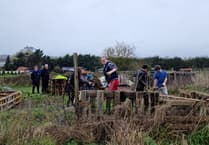Scientists and conservationists often need the public’s help by telling them what creatures we spot. The experts say this work by “citizen scientists” is essential, so they can understand how different species are faring and help those that are struggling.
A new project launched last week asks for we nature lovers to help wildlife without leaving the comfort of our homes, so those with mobility issues or who don’t have a garden can play a valuable part. We simply have to look at images online and say what creatures we see!
By contrast, most appeals ask us to go out and count. These surveys include the annual butterfly count by the Butterfly Conservation charity, a mammal survey by the People’s Trust for Endangered Species (PTES) and the annual garden bird count conducted by the RSPB.
The National Hedgehog Monitoring Programme (NHMP) will help address the dramatic decline in hedgehogs across the country, so practical conservation measures can be put in place.
The project uses trail cameras to capture images of hedgehogs and other wildlife across the country, in different habitats including urban parks, private gardens, woodlands and farmland. It generates thousands of images.
The species in these images need to be identified, which is achieved using a mixture of Artificial Intelligence (AI) and human volunteers. We home-based spotters simply look through a sequence of images, tag which species we see, and continue. Free training and ID guides are available online.

This unique combination of AI, trail cameras and home-based volunteers will provide crucial insights into the reasons for a dramatic decline in hedgehog numbers – between 30 and 75% across different areas of the countryside since 2000, according to a State of Britain’s Hedgehogs 2022 report from the wildlife charities British Hedgehog Preservation Society (BHPS) and People’s Trust for Endangered Species (PTES).
The National Hedgehog Monitoring Programme project is led by the BHPS and the PTES in partnership with Nottingham Trent University, ZSL’s London HogWatch, Durham University and MammalWeb. It is largely funded by Natural England.
Fay Vass, CEO of the BHPS said: “Everyone loves hedgehogs, but we recognise not everyone is in a position to help them in the wild. Becoming a ‘spotter’ for the National Hedgehog Monitoring Programme is a fantastic way for everyone to get involved. Helping hedgehogs has never been easier or more accessible, so we really hope people from all walks of life take part.”
Dr Henrietta Pringle of PTES added: “For the first time in the history of hedgehog conservation we’re using AI to open up new opportunities, which is extremely exciting. This
is the first study where populations are measured year after year, which will allow us to see regional and habitat differences, and identify what factors impact them in different places.”

The NHMP team, with the help of a pilot group of volunteers, has already started the enormous task of checking the images from the 13 sites surveyed in 2023. Hedgehogs have been spotted at six of them so far, and many other interesting species have also been seen, such as tawny owls, stoats and red squirrels.
Over the three years of the NHMP’s pilot, the team will place cameras at an increasing number of sites across Britain. The ambition is to have surveyed 40 sites by the end of the trial. To find out more and to sign up, visit www.nhmp.co.uk




